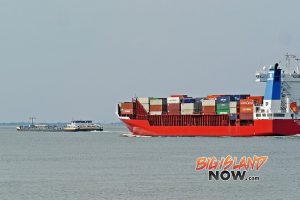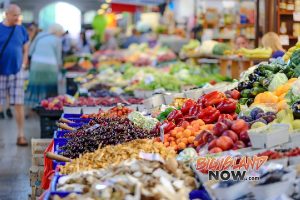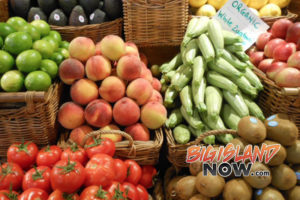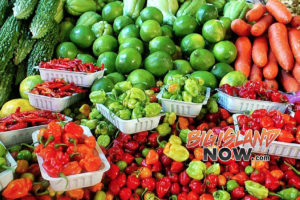Is Food Sustainability Possible in Hawai‘i?
Hilo (population 45,648) has the priciest groceries of any American city. Hawai‘i is known for having a high cost of living, but with such a great climate for agriculture, why don’t we produce enough food to affordably sustain our population?
The Problem
Janelle Saneishi, public information officer of the Hawai‘i Department of Agriculture, informed us that an estimated 3,000 tons (6 million pounds) of food are imported on a daily basis, according to the Hawai‘i Emergency Management Agency (HI-EMA) at a cost of more than $3 billion dollars per year.
 Part of the reason food is so expensive is because importers and producers have to increase prices to account for having nearly a third of the food that is imported spoils due to the hot, humid climate before it reaches the shelves. And climate change has the potential to raise costs even more in upcoming years. In addition, at least half of the seafood we consume comes from the mainland.
Part of the reason food is so expensive is because importers and producers have to increase prices to account for having nearly a third of the food that is imported spoils due to the hot, humid climate before it reaches the shelves. And climate change has the potential to raise costs even more in upcoming years. In addition, at least half of the seafood we consume comes from the mainland.
Surprisingly, Hawai‘i’s top agriculture export isn’t meant for consumption, including seeds (about half of which are genetically engineered, according to the Hawai‘i DOA). Seed exports were more than twice as valuable as our No. 2 export, macadamia nuts, followed by cattle and coffee.
But not all seed crops in Hawai‘i are genetically engineered (GE). About half of all seed crops grown in the state are conventional crops. GE seed crops are not grown on the Island of Hawai‘i.
You would think, given the markup cost of imported food, we would be able to produce our locally for less money—but we don’t. The Hawai‘i DOA explained that farmers may be discouraged to produce more because there is a bigger profit margin in producing less.
“Hawai‘i has about 1.135 million acres statewide designated as agricultural lands (catch-all),” Saneishi shared with Big Island Now. “These lands include gulches, ravines and steep terrains that are not suitable for growing crops. The 2017 agriculture census estimated total harvested cropland in Hawai‘i at 84,767 acres. Additionally, property rights and free enterprise in the Hawai‘i/U.S. permit farmers and ranchers to freely choose how much to produce or not produce. Usually, they are motivated to provide more, with higher market prices and higher profits. Government cannot dictate that farmers grow more food. Additionally, the law of supply rules that a higher quantity of supply produced will lower market price with constant demand and thereby lowering profits to farmers.”
 While the Hawai‘i DOA data concludes there is about 7,000 farms statewide, only 3% of those brought in more than $250,000 in sales in 2017.
While the Hawai‘i DOA data concludes there is about 7,000 farms statewide, only 3% of those brought in more than $250,000 in sales in 2017.
Helping Farmers
For these reasons, the state is making an effort to encourage more residents to get involved in farming and help local agriculture producers. Learn more about some of these initiatives by visiting Go Farm Hawaii (a University of Hawai‘i-College of Tropical Agriculture and Human Resources program), the Beginning Farmer-Rancher Development Program (Kohala Center) and the Kauhale Youth Leadership (MA‘O Farms youth internship program). Also, at the K-12 level, some schools have 4-H Youth and FFA programs.
Since taking office in 2014, Gov. David Ige has stated that he aims to double statewide food production by 2020. He has requested $12.5 million in agricultural loan money to help new and existing farms and another $12.5 million in capital improvement funds to maintain irrigation systems.
Another way Gov. Ige intends to help farmers is by making the switch to more affordable sustainable energy, signing legislation committing the state to use 100% sustainable energy by 2045, which would help decrease production costs for local farmers.
 However, Saneishi said, “It is certainly helpful to lowering the cost of local crop production; with the caveat that energy source costs less than petroleum-based energy (e.g., gas and electricity). This is usually not the case when crude oil price is under $120 per barrel. Additionally, renewable energy requires substantial investments that is not frequently available to agricultural producers (farmers and ranchers).”
However, Saneishi said, “It is certainly helpful to lowering the cost of local crop production; with the caveat that energy source costs less than petroleum-based energy (e.g., gas and electricity). This is usually not the case when crude oil price is under $120 per barrel. Additionally, renewable energy requires substantial investments that is not frequently available to agricultural producers (farmers and ranchers).”
How You Can Help
When evaluating the importance of “eating local,” residents should be aware that currently, if a natural disaster were to occur and barges were to stop, it is estimated there would be only three days worth of food left on the shelves in local grocery stores.
Local grocery stores like KTA are also trying to encourage more people to buy local to increase demand and help motivate local farmers. KTA Super Stores Executive Vice President Derek Kurisu, told Big Island Now, “We advertise a lot in our print ads, radio, store signs and speeches to various organizations and classrooms. The emphasis is to promote locally grown or manufactured products. Our private label, Mountain Apple Brand, consists of locally grown or manufactured products.”
Many fruits and vegetables are actually cost-competitive with imported produce. UH found that 80% of our tomatoes and all of our watercress are produced locally. According to the Hawai‘i DOA, consumers can be thrifty shopper while supporting local products by making sure to purchase watermelons, mangoes, avocados, apple bananas, dragon fruits, cabbages, Mānoa lettuce, basil, sweet potatoes and macadamia nuts that are produced locally.

Kurisu told Big Island Now that at KTA, “95% of our leafy vegetables in the produce department are locally grown; 100% of our papayas, pineapples and bananas are locally grown; 100% of the melons are purchased locally when in season. Our pumpkins are locally grown during Halloween… In the produce department, we try to support local first. Forty-five percent of our local beef sales are local grass-fed beef; 5% of our pork sales are local and 60% of our seafood sales are from local waters. We import frozen seafood like shrimps, butterfish, etc., due to the lack of supply. About 65% of our fresh milk sales were from local dairy before the closing of Hāmākua Dairy and problems with Clover Leaf dairy in Kohala. Today, local milk makes up only about 20% of KTA’s fresh milk sales. Currently, we are working with Clover Leaf to improve our milk supply, so I am confident that within the next three months, it will go back to 65%.“
Another way to encourage food sustainability on our islands is by substituting your starches such as wheat and rice for varieties that can be produced locally, like taro and breadfruit, which sustained ancient Hawaiians.
Soon, Costco may also be promoting the local diet. The big box store announced it is considering a greenhouse project to complement the food production of local farmers and help Hawai‘i grow more of our own food on our own land.
 Potential for Growth
Potential for Growth
A recent study states we would be able to produce most of the food we need to sustain us if people are willing to change their diet and create the demand.
Also, some of the 48% of our land that is currently designated for conservation would have to be utilized for crops and urban development, climate change and population growth also make food sustainability more difficult.
The study found that more than 40% of land designated as agriculture lands are currently not in use and are suited to for restoration of indigenous crops.
If the government, local residents, farmers and grocery stores can work together, we will all have a better chance of survival in an uncertain future.














